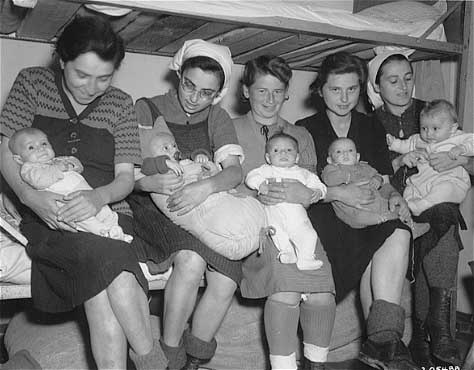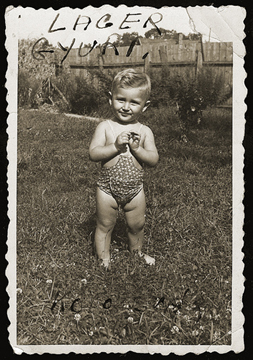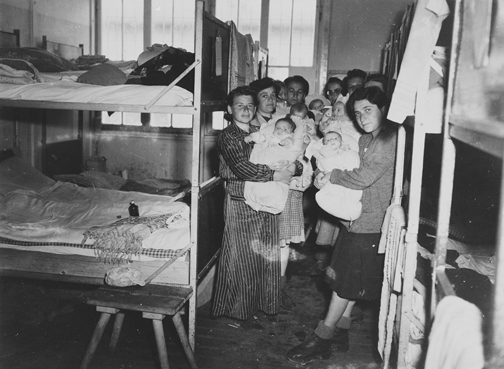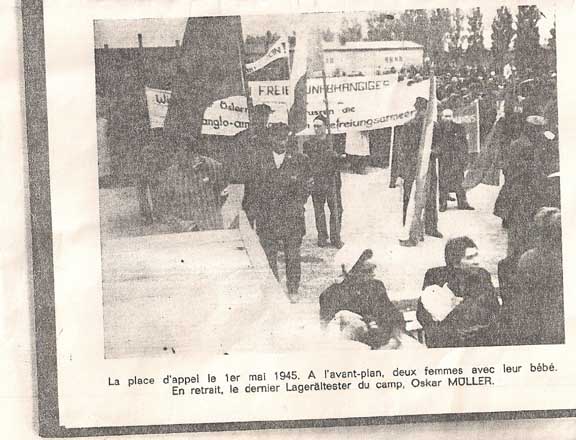Babies at Dachau
Starting in May 1944, thousands of Hungarian
Jewish women were transported to the Auschwitz-Birkenau death camp, but were then transferred to one of the eleven Kaufering sub-camps of Dachau, which were located near Landsberg am Lech in Germany. Seven of the Hungarian women, who were pregnant, were put into the "Schwanger Kommando," in one of the eleven Kaufering sub-camps in December 1944. All seven of the mothers gave birth to healthy babies in February 1945.
Just before Dachau was liberated on April 29, 1945, the women and their babies were evacuated from the Kaufering camp and put on a train bound for the main camp. On the way, the train was hit by Allied bombs, but the women and their babies survived; they arrived at Dachau shortly after the liberation.
 Hungarian Jewish women
with their babies at Dachau, May 1945
Hungarian Jewish women
with their babies at Dachau, May 1945
Shown from left to right in the photo
above are: Iboyla Kovacs with her daughter Agnes; Suri Hirsch
with her son Yossi; Eva Schwartz with her daughter Maria; Magda
with her daughter; and Boeszi Legmann with her son Gyuri.
The women are sitting on a bunk bed in
a hospital barrack. It was very cold in Germany in the Spring
of 1945 and it snowed on May 1st. Notice that the women are wearing
knee socks that are rolled down, so it must have been warm in
the barrack. The mothers and the babies look remarkably healthy
considering that the prisoners at Dachau were sick and starving,
according to the accounts of the American liberators.
 Gyuri Legmann, son
of Boeszi Legmann
Gyuri Legmann, son
of Boeszi Legmann
The photo above shows Gyuri Legmann,
one of the babies born in the Schwanger (pregnant) Kommando at
a Kaufering sub-camp of Dachau.
A few other babies and small children
survived the Nazi death camps. The photo below shows infants
and small children coming out of the Auschwitz-Birkenau camp
after it was liberated by Soviet troops.
 Child survivors of
Birkenau death camp
Child survivors of
Birkenau death camp
 Jewish mothers with their babies in a hospital barrack at Dachau, May 1945
Jewish mothers with their babies in a hospital barrack at Dachau, May 1945
Shown from the left in the photo above
are Iboyla Kovacs with her daughter Agnes; Suri Hirsch with her
son Yossi; Eva Schwartz with her daughter Maria; Magda with her
daughter; Boeszi Legmann with her son Gyuri; Dora Loewy and her
daughter Szuszi; and Miriam Schwarcz Rosenthal with her son Laci
(Leslie).
According to the United States Holocaust
Memorial Museum, babies were normally killed in all the Nazi
concentration camps, but the babies shown in the photo above
were allowed to live because the war would soon be over and the
Nazis wanted to use these babies as bargaining chips in negotiations
with the Allies.

Demonstration at Dachau
after the camp was liberated, May 1945
Shown in the photo above are two Jewish
mothers with their babies at a demonstration in the Dachau main
camp after the camp was liberated.
Miriam Schwarcz Rosenthal was the last of the mothers to give birth at Kaufering. Miriam was one of the 14 children of Jeno and Laura Schwarcz of Komarno, Czechoslovakia. After Czechoslovakia was jointly invaded by Germany, Hungary and Poland in 1938, the section of Czechoslovakia where the Schwarcz family lived was taken over by Hungary. On April 5, 1944, Marian was married to William Rosenthal, and two weeks later, she became separated from her husband when she was sent to a ghetto.
Miriam was deported to Auschwitz-Birkenau, along with her husband's family, in the middle of May 1944.
Miriam survived the first selection for
the gas chamer upon her arrival at Birkenau and was assigned
to the women's barracks where, after several weeks, she realized
she was pregnant. In order to get out of Birkenau, she volunteered
for a transport to the Plaszow concentration camp in Krakow. After
only a few weeks of working at Plaszow, the camp that is shown
in the movie Schindler's List, she was sent back to Auschwitz-Birkeanu.
Upon her arrival at Birkenau, Miriam survived another selection for the gas chamber, although she was obviously pregnant. According to Miriam, the SS guards would ask the women who were pregnant at Auschwitz-Birkenau to step forward to receive extra rations, but the women thought that this was a trick to get them to identify themselves so that they could be sent to the gas chamber.
Miriam was soon transferred again, this time to a sub-camp of Dachau in Augsburg, Germany where she was assigned to work in a Messerschmitt airplane factory. One day in December 1944, while at work in the factory, two SS men noticed that she was pregnant; they escorted her on a passenger train to one of the Kaufering sub-camps of Dachau near Landsberg am Lech, where she was placed in a barrack with six other pregnant women who would soon be ready to give birth. Even though they were pregnant, the women were forced to work in the camp laundry.
In February 1945, the women at Kaufering
started to give birth. A Hungarian Jewish gynecologist was assigned
to help them through, even though he was too weak to stand. A
Jewish kapo working in the kitchen had kept the women alive during
their pregnancy by sneaking them extra rations.
On February 28, 1945, Miriam was the last to give birth and she became very ill afterwards. Boeszi Legmann nursed Miriam's baby until Miriam recovered.
More information about Miriam Rosenthal's
ordeal in the camps can be found on these two web sites:
http://www.shomayim.org/home.do?ch=content&cid=3
390
http://www.njch.org/holocaust/pdf/miriam_rosenthal.p df
This page was last updated on March 3,
2009
|